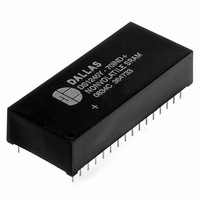DS1556-70+ Maxim Integrated Products, DS1556-70+ Datasheet - Page 5

DS1556-70+
Manufacturer Part Number
DS1556-70+
Description
IC RTC RAM Y2K 5V 70NS 32-EDIP
Manufacturer
Maxim Integrated Products
Type
Clock/Calendar/NVSRAM/Y2Kr
Datasheet
1.DS1556P-70.pdf
(18 pages)
Specifications of DS1556-70+
Memory Size
1M (128K x 8)
Time Format
HH:MM:SS (24 hr)
Date Format
YY-MM-DD-dd
Interface
Parallel
Voltage - Supply
4.5 V ~ 5.5 V
Operating Temperature
0°C ~ 70°C
Mounting Type
Through Hole
Package / Case
32-DIP Module (600 mil), 32-EDIP
Lead Free Status / RoHS Status
Lead free / RoHS Compliant
a typical application, the OE signal will be high during a write cycle. However, OE can be active
provided that care is taken with the data bus to avoid bus contention. If OE is low prior to WE
transitioning low, the data bus can become active with read data defined by the address inputs. A low
transition on WE will then disable the outputs t
DATA-RETENTION MODE
The 5V device is fully accessible and data can be written and read only when V
However, when V
internal clock registers and SRAM are blocked from any access. When V
point V
battery. RTC operation and SRAM data are maintained from the battery until V
levels.
The 3.3V device is fully accessible and data can be written and read only when V
hen V
switched from V
than V
below V
nominal levels.
All control, data, and address signals must be powered down when V
BATTERY LONGEVITY
The DS1556 has a lithium power source that is designed to provide energy for the clock activity, and
clock and RAM data retention when the V
supply is sufficient to power the DS1556 continuously for the life of the equipment in which it is
installed. For specification purposes, the life expectancy is 10 years at 25C with the internal clock
oscillator running in the absence of V
source disconnected, guaranteeing full energy capacity. When V
V
DS1556 will be much longer than 10 years since no internal battery energy is consumed when V
present.
INTERNAL BATTERY MONITOR
The DS1556 constantly monitors the battery voltage of the internal battery. The Battery Low Flag (BLF)
bit of the Flags Register (B4 of 1FFF0h) is not writable and should always be a 0 when read. If a 1 is ever
present, an exhausted lithium energy source is indicated and both the contents of the RTC and RAM are
questionable.
POWER-ON RESET
A temperature compensated comparator circuit monitors the level of V
fail trip point, the RST signal (open drain) is pulled low. When V
signal continues to be pulled low for a period of 40 ms to 200 ms. The power-on reset function is
independent of the RTC oscillator and thus is operational whether or not the oscillator is enabled.
PF
, the lithium energy source is enabled for battery backup operation. Actual life expectancy of the
CC
SO
SO
, the device power is switched from V
SO
falls below V
(battery supply level), device power is switched from the V
. RTC operation and SRAM data are maintained from the battery until V
CC
CC
to the internal backup lithium battery when V
is below the power-fail point V
PF
, access to the device is inhibited. If V
CC
. Each DS1556 is shipped from Maxim with its lithium energy
CC
supply is not present. The capability of this internal power
WEZ
CC
5 of 18
DS1556 1M, Nonvolatile, Y2K-Compliant Timekeeping RAM
to the internal backup lithium battery when V
after WE goes active.
PF
(point at which write protection occurs) the
CC
PF
CC
CC
is less than V
is first applied at a level greater than
CC
CC
drops below V
returns to nominal levels, the RST
is powered down.
pin to the internal backup lithium
CC
CC
. When V
falls below the battery switch
CC
SO
CC
CC
is returned to nominal
, the device power is
CC
PF
is greater than V
is greater than V
. If V
falls to the power
CC
is returned to
PF
is greater
CC
drops
CC
PF
PF
is
.
.












